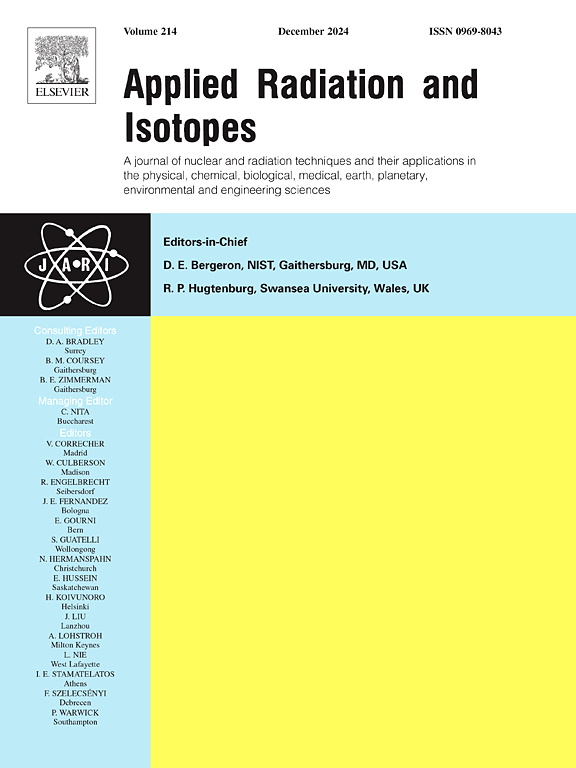Advanced sorption mechanism analysis of Cs(I) and Eu(III) onto Ni-Fe-Sm fulvic acid: A comprehensive study of kinetics, isotherms, and dual-site binding analysis
IF 1.6
3区 工程技术
Q3 CHEMISTRY, INORGANIC & NUCLEAR
引用次数: 0
Abstract
The sorption behavior of cesium and europium onto magnetic Ni-Fe-Sm oxide incorporated with fulvic acid (Ni-Fe-Sm/FA) was systematically investigated under controlled temperatures (298, 308, and 328 K) in a single-component sorption system. The synthesized composite exhibited ferromagnetic behavior, with a saturation magnetization of approximately 40–45 emu/g, demonstrating its suitability for magnetic separation and environmental applications. Kinetic analysis confirmed that the sorption of Cs(I) and Eu(III) followed a pseudo-second-order model, indicated that chemisorption is the dominant mechanism. Equilibrium data was best described by the dual Langmuir isotherm model, suggesting the presence of multiple types of sorption sites. Further interpretation using four statistical physics models—mono-layer sorption with a single binding site (MSSBS), mono-layer sorption with two distinct energy sites (MSTBS), double-layer sorption with one binding site (DLSMOBS), and double-layer sorption with two binding sites (DLSMTBS)—provided deeper insights into the heterogeneous nature of the sorbent surface. Model parameters revealed that sorption occurred at distinct surface regions with varying affinities and capacities, suggesting the existence of energetically diverse binding sites. Thermodynamic analysis confirmed the endothermic nature of the sorption process, with Eu(III) exhibiting significantly higher sorption capacity than Cs(I), attributed to stronger electrostatic interactions and complexation with functional groups. These findings elucidate the fundamental interaction mechanisms between the sorbates and the Ni-Fe-Sm/FA composite, highlighting the influence of temperature and surface heterogeneity on the sorption efficiency.
Cs(I)和Eu(III)在Ni-Fe-Sm富里酸上的高级吸附机理分析:动力学、等温线和双位点结合分析的综合研究
在控制温度(298、308和328 K)的单组分吸附体系中,系统地研究了含黄腐酸的磁性Ni-Fe-Sm氧化物(Ni-Fe-Sm/FA)对铯和铕的吸附行为。合成的复合材料表现出铁磁性,饱和磁化强度约为40-45 emu/g,表明其适合磁分离和环境应用。动力学分析证实了Cs(I)和Eu(III)的吸附服从伪二阶模型,表明化学吸附是主要吸附机理。双Langmuir等温线模型最能描述平衡数据,表明存在多种类型的吸附位点。利用四种统计物理模型——单结合位点的单层吸附(MSSBS)、具有两个不同能量位点的单层吸附(MSTBS)、具有一个结合位点的双层吸附(DLSMOBS)和具有两个结合位点的双层吸附(DLSMTBS)——进一步解释了吸附剂表面的异质性。模型参数显示,吸附发生在具有不同亲和力和能力的不同表面区域,表明存在能量多样化的结合位点。热力学分析证实了吸附过程的吸热性质,由于更强的静电相互作用和与官能团的络合作用,Eu(III)的吸附能力明显高于Cs(I)。这些发现阐明了吸附剂与Ni-Fe-Sm/FA复合材料之间的基本相互作用机制,突出了温度和表面非均质性对吸附效率的影响。
本文章由计算机程序翻译,如有差异,请以英文原文为准。
求助全文
约1分钟内获得全文
求助全文
来源期刊

Applied Radiation and Isotopes
工程技术-核科学技术
CiteScore
3.00
自引率
12.50%
发文量
406
审稿时长
13.5 months
期刊介绍:
Applied Radiation and Isotopes provides a high quality medium for the publication of substantial, original and scientific and technological papers on the development and peaceful application of nuclear, radiation and radionuclide techniques in chemistry, physics, biochemistry, biology, medicine, security, engineering and in the earth, planetary and environmental sciences, all including dosimetry. Nuclear techniques are defined in the broadest sense and both experimental and theoretical papers are welcome. They include the development and use of α- and β-particles, X-rays and γ-rays, neutrons and other nuclear particles and radiations from all sources, including radionuclides, synchrotron sources, cyclotrons and reactors and from the natural environment.
The journal aims to publish papers with significance to an international audience, containing substantial novelty and scientific impact. The Editors reserve the rights to reject, with or without external review, papers that do not meet these criteria.
Papers dealing with radiation processing, i.e., where radiation is used to bring about a biological, chemical or physical change in a material, should be directed to our sister journal Radiation Physics and Chemistry.
 求助内容:
求助内容: 应助结果提醒方式:
应助结果提醒方式:


